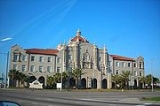
Gulf, Mobile, and Ohio Passenger Terminal
Encyclopedia
The Gulf, Mobile, and Ohio Passenger Terminal is a historic train station
in Mobile
, Alabama
, United States
. Architect P. Thorton Mayre designed the Mission Revival
style terminal for the Mobile and Ohio Railroad
. It was completed in 1907 at a total cost of $575,000. The Mobile and Ohio merged with the Gulf, Mobile and Northern Railroad
in 1940 to form the Gulf, Mobile and Ohio Railroad
. Passenger service was discontinued by the late 1950s, and the building served as railroad offices. The terminal was placed on the National Register of Historic Places
on August 15, 1975. It had suffered neglect, extensive interior alteration, and partial removal of the train shed by this time. The Gulf, Mobile and Ohio Railroad vacated the building in 1986 and for fifteen years it suffered from demolition-by-neglect. The Alabama Historical Commission
and the Alabama Trust for Historic Preservation named it as one of their "Places in Peril" in 1996. In 2001 the City of Mobile
and a private company invested more than $18 million to restore the local landmark with the developer taking advantage of the Federal Historic Preservation Tax Incentive program. Today the building houses private offices and the city's Metro Transit Authority.
Train station
A train station, also called a railroad station or railway station and often shortened to just station,"Station" is commonly understood to mean "train station" unless otherwise qualified. This is evident from dictionary entries e.g...
in Mobile
Mobile, Alabama
Mobile is the third most populous city in the Southern US state of Alabama and is the county seat of Mobile County. It is located on the Mobile River and the central Gulf Coast of the United States. The population within the city limits was 195,111 during the 2010 census. It is the largest...
, Alabama
Alabama
Alabama is a state located in the southeastern region of the United States. It is bordered by Tennessee to the north, Georgia to the east, Florida and the Gulf of Mexico to the south, and Mississippi to the west. Alabama ranks 30th in total land area and ranks second in the size of its inland...
, United States
United States
The United States of America is a federal constitutional republic comprising fifty states and a federal district...
. Architect P. Thorton Mayre designed the Mission Revival
Mission Revival Style architecture
The Mission Revival Style was an architectural movement that began in the late 19th century for a colonial style's revivalism and reinterpretation, which drew inspiration from the late 18th and early 19th century Spanish missions in California....
style terminal for the Mobile and Ohio Railroad
Mobile and Ohio Railroad
The Mobile and Ohio Railroad was a railroad in the Southern U.S. The M&O was chartered in January and February 1848 by the states of Alabama, Kentucky, Mississippi, and Tennessee. It was planned to span the distance between the seaport of Mobile, Alabama and the Ohio River near Cairo, Illinois...
. It was completed in 1907 at a total cost of $575,000. The Mobile and Ohio merged with the Gulf, Mobile and Northern Railroad
Gulf, Mobile and Northern Railroad
The Gulf, Mobile and Northern Railroad was a railroad in the Southern United States. The first World War had forced government operation upon the company; and in 1919, when it became once more a free agent, it chose Ike Tigrett to charter its new course...
in 1940 to form the Gulf, Mobile and Ohio Railroad
Gulf, Mobile and Ohio Railroad
The Gulf, Mobile and Ohio was a Class I railroad in the central United States whose primary routes extended from Mobile, Alabama, and New Orleans, Louisiana, to St...
. Passenger service was discontinued by the late 1950s, and the building served as railroad offices. The terminal was placed on the National Register of Historic Places
National Register of Historic Places
The National Register of Historic Places is the United States government's official list of districts, sites, buildings, structures, and objects deemed worthy of preservation...
on August 15, 1975. It had suffered neglect, extensive interior alteration, and partial removal of the train shed by this time. The Gulf, Mobile and Ohio Railroad vacated the building in 1986 and for fifteen years it suffered from demolition-by-neglect. The Alabama Historical Commission
Alabama Historical Commission
The Alabama Historical Commission is the historic preservation agency for the U. S. state of Alabama. The agency was created by an act of the state legislature in 1966 with a mission of safeguarding Alabama’s historic buildings and sites. It consists of twenty members appointed by the state...
and the Alabama Trust for Historic Preservation named it as one of their "Places in Peril" in 1996. In 2001 the City of Mobile
Mobile, Alabama
Mobile is the third most populous city in the Southern US state of Alabama and is the county seat of Mobile County. It is located on the Mobile River and the central Gulf Coast of the United States. The population within the city limits was 195,111 during the 2010 census. It is the largest...
and a private company invested more than $18 million to restore the local landmark with the developer taking advantage of the Federal Historic Preservation Tax Incentive program. Today the building houses private offices and the city's Metro Transit Authority.

